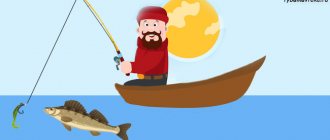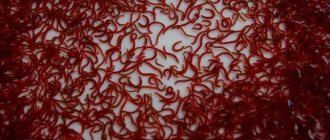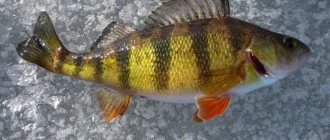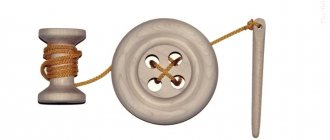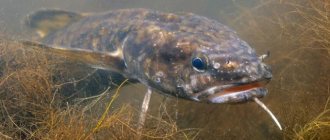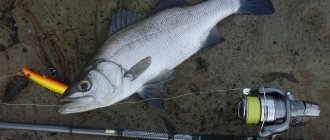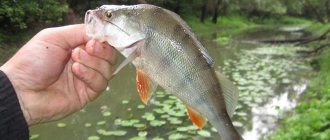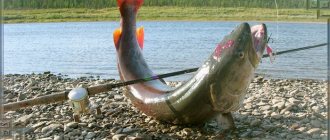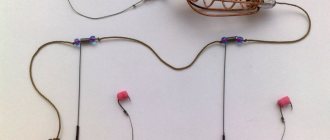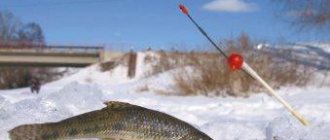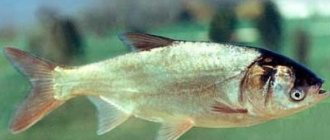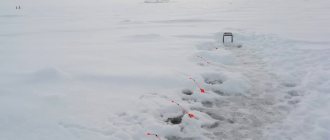One of the most effective and at the same time simplest ways to find fish in the dead of winter is to choose a snagdy area. It concentrates fish of various species, more active ones, and therefore representing potential targets for fishing with different baits.
I will briefly note the advantages of snags: trees, stumps, bushes protruding from the water, wooden piles, etc. – correct all-season reference points, including winter ones. Fish find shelter and food here. It is not for nothing that some fishermen from the old guard still resort to a simple but true technique. In a clean water area, a small fir tree or a bundle of fir branches with a stone tied to the butt is sunk to the bottom through a hole, thereby creating a haven for fish. They put a pole on the ice so that it is easy to find the launch point, and after a couple of days they start fishing, and quite successfully.
Correct wiring in snag
Many people have probably noticed that if you make a jig step in a snag upstream of an anchored boat, then there are many more hooks, and almost all of them are “dead”. And none of the most proven non-hooking devices help. It's all about the sharp angle that forms the cord as a result of the bait being carried away by the current at the moment it encounters an obstacle. As a result of this, the cut becomes deeper, and the current turns the bait with hooks towards the hook. When we cast downstream, this angle is obtuse. The bait floats slightly in the current, and the main line only touches the future obstacle. It is for this reason that many advise using lighter weights when fishing in snags. Less weight means less cutting depth, making it easier to shake the bait off the hook.
It becomes obvious that the sharpness of this angle must be avoided or somehow dealt with. For example, when I fish from the bank and catch a promising snag, after a bite that occurs directly opposite me, very often I move along the bank a little higher upstream and fish this place with less likelihood of hooks precisely because of the more obtuse angle between the line and the bait. At the same time, the bait stays in the bite zone a little longer due to the fact that it sails a little stronger in the current.
Tactics for finding perch in snags
Snags predominate in bodies of water, both with stagnant, dirty water, and among the muddy banks of large rivers. You can find it almost everywhere, and you may have difficulty finding it only in the dead of winter, when the striped fish goes far from the shore and lies down on the bottom in order to survive bad weather, which it cannot stand.
Large individuals are caught every now and then at great depths, but even in snags completely littered with garbage they are frequent guests. Usually, in order to check the presence of perch in the summer, it is enough to throw a jig once, which has the peculiarity of not immediately clinging to the nearest branch or grass stem growing high up.
A little wiring will reveal the location of the hunter, or his complete absence. It can be fed with ordinary earthworms or other live food; bread is suitable for attracting small fry, which in turn will attract the humpback.
Perch is a fierce predator, and this makes the smell of blood especially attractive to it. Soak pieces of bread in the blood (which can be strained from pieces of meat bought at the market) or pour it directly into the water, after which you can safely throw your bait in there; surely some humpbacked glutton will soon grab it.
In bad weather, during rain or even at low pressure, it is better to give up searching for representatives of this species for the reason that at this time they usually sleep in their burrows. But a clear, sunny day is, on the contrary, the best time to go hunting for trophies.
Jig rig with bullet
There is one treasured place on the Volga where decent pike live. The location is convenient because there is a jam in the downstream due to a fallen tree, to which you can easily tie the bow of the boat. Below this place there is a strong snag at a depth of 6–7 m. “Cheburashkas” do not live long in this place. You have to place a weight weighing 40 grams to reach the bottom. One day I suddenly ran out of heavy weights. I decided to experiment. He took off the leash, threaded the cord into the sliding weight “bullet” and then tied the lighter weight “Cheburashka”.
"Bullet" with "Cheburashka"
The bait became a little heavier, but nevertheless it passed the snag easier. This is understandable; a sharp nose has appeared, which I spoke about at the very beginning. One annoyance - the pikes began to cut off the bait at the first bite, and I lost two weights and the bait at once. Catching pike on a jig without a metal leash is a thankless task. I prepared more seriously for the next fishing trip. Since I make string leashes myself, I decided to insert such a leash into the “bullet” weight ahead of time. This design received the logical name “bullet on a string”. At the same time, there was no need for a winding ring between the foam fish and the load. At the same time, one question haunted me: how would the double’s hooks be positioned on a foam fish? After all, the “bullet” has no offset, and should not orient the bait in the desired position. Not really believing in the success of my plan, I made several of these structures and went fishing. To my joy and surprise, every time the bait returned “live” from a blind snag, the hooks of the foam fish were oriented upward.
Most often, foam rubber hooks are oriented correctly
Apparently, the forend of the double and a strip of dried glue serve as an excellent keel in the geometry of the bait. Moreover, I noticed that after the first cast, the string just above the nose of the “bullet” takes on a subtle bend, which is maintained during subsequent casts and helps the bait take the correct position. Moreover, shaking baits off hooks has become even easier. Obviously, the spring properties of the wire contribute to this. Apparently, when the leash meets a branch, it helps to keep the “deadly” angle at the most gentle degree. And when a cut is made with the cord, the wire makes it easier to pierce the groove a little wider, and the sharp nose of the “bullet” helps to knock the bait out of the hook. Well, what about pikes, you ask? They appreciated my equipment. A lot of boats passing by sympathetically told me that, apparently, this was my first time fishing here and that I would soon tear off all my baits. I only ironically thanked them for their compassionate advice.
Tackle and equipment of a spinning angler when fishing on the river
You need to prepare for river trips. Equipment should be convenient and comfortable. After all, you will have to spend almost the whole day on the boat. It is better to wear rubber boots on your feet - sometimes you need to go ashore, and the shore is not always sandy. For small accessories, it is better to get a multifunctional vest. To store fish you need to have a reliable cucan made of thin wire. Sometimes you can get caught in short-term rain, and sometimes in prolonged rain. There is nowhere to hide. This is where taking a cloak or cape with you will save you.
To land fish, you will need a landing net equipped with a large mesh net made of thick fishing line.
The choice of rod and reel directly depends on the type of bait you are going to fish with. But what to use, braided cord or monofilament line, is a controversial issue. But the fact that when using monofilament fishing line there are three times more bites than when using cord is a proven fact.
Having a large number of baits in a fishing box is not a fishing fetish, but an everyday necessity when fishing in difficult snags. But the presence of expensive gear (rod, reel, line) is not snobbery, but a healthy desire for perfection. High-quality gear is not designed for wealthy fishermen, but for sports fishermen who know a lot about them and their capabilities. Remember this.
Of course, what to do and what tactics to choose must be assessed in each individual case. Remember that fishing does not accept templates. Yesterday the water was clear, but today it is cloudy after rain. Yesterday the water in the river fell, but today it rose, etc. That’s why pessimists came up with the phrase: “The best bite was yesterday and tomorrow.” Optimists, having not caught a fish, thank fate for an extraordinary vacation away from the metropolis.
Views: 93
Similar articles:
- How to catch pike in the fall on the river The climate of our country has become more and more...
- Catching pike with a jig in the fall How to catch pike with a jig in the fall and where to look for a toothy...
- How to properly catch pike with a spinning rod: tackle, choice of bait, fishing technique Active search for fish for me is always the beginning of fishing...
- Catching pike in the fall with a spinner I don’t know how right I am, but it seems to me that a spinning rod...
Universal equipment for snags
In this amazing way, a “bullet on a string” appeared in my arsenal. My fishermen friends who prefer to fish in snags with offset hooks also liked it.
There is no longer any need to come up with the idea of attaching hooks to the “Cheburashka ear.” It is enough to slightly pull the wire out of the “bullet”, untwist the twist and attach the desired hook. Everything is done simply and quickly. No additional clasps or winding rings are needed. It is enough to give the wire the desired angle by hand at the very nose of the “bullet” - and the offset hook will be oriented as desired. Shaking baits off hooks has never been easier. Obviously, the spring properties of the wire contribute to this. Apparently, when the leash meets a branch, it helps to keep the “deadly angle” at the most gentle degree.
Fishing with wobblers in snags
The topic of fishing with spinning baits in impassable snags is very specific and is of little demand. Most fishermen simply pass by such places on the reservoir, preferring not to bother with the difficulties that await them. They are frightened by the possible loss of baits, sometimes very expensive ones - of course, such a prospect appeals to few people. This especially applies to wobblers, which in such conditions turn into potential suicide bombers - two tees leave them practically no chance for a long life. So why look for unnecessary problems on your head? After all, it is much easier to catch, for example, the same pike, in cleaner areas - here the choice of suitable baits will be many times wider, and you can fish in a comfortable mode and without the constant fear of getting a dead hook.
However, all kinds of predatory fish like to stand in the rubble of snags, from pike and pike perch to catfish and asp - here they feel completely safe, since practically no one fishes here, and poachers have nothing to do - the intricacy of the branches of the underwater forest is not conducive to fishing with nets . And for those spinners who are not looking for the easy way out and are not used to giving up without a fight, there is only one way out - try to adapt to fishing in snags, minimizing the loss of bait if possible. But the game, believe me, is worth the candle.

How I started fishing in snags
Several years ago, fate brought me to such a place - deserted and very rich in pike, but so heavily snagged that, willy-nilly, I had to learn to fish in these difficult conditions. The creative process has always been very interesting for me, and soon I very successfully adapted to fishing in this underwater windbreak, and over time this body of water became my favorite. It was a narrow river, winding in a winding ribbon, with steep and wooded banks, and trees everywhere came close to the water. During the spring flood, trees washed away by the fast spring current fell into the water from the steep slopes. Numerous beavers, who lived here in entire colonies, also contributed to the “logging”. As a result, the entire riverbed, with greater or lesser density, was dotted with trees lying in the water - both small and real giants, with trunks two or three girths thick. In some places they lay alone in the water, but in some areas real impassable rubble formed, through which it was difficult to get through by boat. All this created some difficulties, but they could be put up with. But the biggest problem for our spinning brother was the trees that lay below the surface and hidden by the water column. Their invisible spreading crowns with a mass of dead branches sticking out in all directions were a death trap for any spinning bait. Moreover, every year the location of the drowned trees changed - the stormy spring current dragged them along the bottom, moving them.
If you fish in that relaxed style, which is practiced in open places with a minimum of hooks, then numerous losses of baits or constant fiddling with the unhooking will be simply guaranteed. Consequently, we need completely different fishing schemes and other baits that would allow more or less safe fishing in this underwater forest, reducing the number of possible hooks to a minimum. In principle, there is nothing extremely difficult in this task for a thinking spinner, so quite quickly, however, using the good old trial and error method, suitable baits were found. I’ll tell you about this in the material offered - such experience may be useful for those spinners who one day find themselves in such conditions.
We will talk about fishing in snags in relation to wobblers, since I use almost only these artificial baits, and using them in snags turned out to be much easier and simpler than it might seem at first glance. On the one hand, with the correct fishing technique, wobblers provide a minimum number of hooks on tree trunks and branches scattered under the surface of the water, on the other hand, they have sufficient catchability and attractiveness for pike. In addition, their fixed maximum depth allows you to avoid the lion's share of dead hooks - this is a very important point.
Tactics for fishing in snags
In moored waters, I practice two tactical schemes: rafting in a free drift and fishing from an anchored boat. And there are some nuances here. Drift fishing is specific in that in most cases it is high-speed, so we always shoot only active pike. We simply don’t have time to torture passive fish, because our boat is carried by the current - and we won’t be able to stay anywhere longer. I fish by rafting only in two cases - when I need to fish a long section of a river without stopping anywhere for a long time, or when the fish are highly active. But a passive pike will not react to a bait rushing past it at high speed and with virtually no pauses, so when the activity of the toothy pike is low, I only fish from an anchor.
High-speed fishing is very suitable for temperamental fidget spinners: 3-5 casts at the point - and we swam further, you will still meet an active pike somewhere. Personally, I prefer to look for active pike in a different way, stopping the boat in places I like. Usually I spend about ten, maximum - fifteen, casts on a point, after which I swim further. So the points are fished not superficially, but rather thoroughly, and at the same time a high fishing rate is maintained. This appeals to me more than “hatching” fish for a long time. Although sometimes the situation develops in such a way that you have to do this too - for example, when the fishing area is very limited and there are not so many places for fishing. I mainly choose this scheme in the complete absence of pike activity. In this case, you anchor at a point and treat it alternately with various baits, trying to bait the pike. Wobblers, spinners, rattlins and any other baits that are in the boxes are used. The calculation here is simple: either by searching you finally find that irritant that at the moment can stir up even an inactive fish, or you simply “borrow” it by flickering different baits under its nose.
Read: How to catch asp using castmaster
Fishing from an anchored boat is much more effective and gives the spinner a much larger choice of baits to use, since retrieving can be done slowly and with precision. For example, when fishing with a suspended wobbler, we have the opportunity to make long pauses, which are almost impossible to use when fishing from a boat drifting with the current. And when hunting for a sluggish pike without long pauses, there is nothing to count on success - and sometimes their duration has to be increased to ten to fifteen seconds. When fishing by rafting, the pulling time is always dictated by the speed with which the current carries the boat - this greatly limits it, making it impossible to diversify the fishing of the bait. In the vast majority of cases, I don’t even anchor, but simply position the boat in a place where there is no current - for example, in some quiet place near the shore or behind a tree trunk lying in the water. The shape of the anchor itself is also very important - it should have a streamlined shape and, if possible, without protruding parts such as claws, otherwise it is very easy to lose it. Underwater debris does not forgive mistakes, and a classic two- or three-claw anchor will be guaranteed to be lost in the first hour of fishing, while a streamlined “daisy” or “mushroom” type model will allow you to stop the boat even in the thickest snags.
Without a casting technique honed to perfection, when fishing in the kingdom of snags, you can’t get anywhere - here you need to master the tackle and be able to perform jewelry-precise casts. You will have to place the bait close to a snag sticking out of the water, and under overhanging tree branches. And the slightest loss of control over casting or an error of even 5-10 cm threatens a dead hook.
Lures for snags
Now let's talk a little about the depth of wobblers used for fishing. A clear understanding of which model should be used and when will determine whether we will catch pike - or whether fishing will turn into a constant and tedious fuss with the unhooking. Let's start by fishing for pike that are in the middle and high stages of activity. This kind of fishing is very simple and enjoyable, because the fish reacts to almost any bait used correctly. It’s easier and easier to choose the depth of the selected wobblers - models that go even in half-water work perfectly, which allows them to easily pass most of the trees lying under the surface. An active pike, which lies in ambush at the entrance and exit of holes, near the trunk of a tree or snag lying in the water, will always start behind the wobbler up half a meter or a meter, or even higher, since it always controls the surface layers. But with a passive predator, the situation is more complicated - here you will have to tinker quite a bit, picking up the key to her, while, willy-nilly, trying your best. A predator that is out of sorts will completely ignore a bait passing above the horizon of its site - sometimes even a few tens of centimeters play a role. There are several options here: either experimentally find the horizon in which the pike is currently standing, using long pauses in the retrieve, or feed the wobbler right under its nose. You definitely need to experiment with pauses in the absence of bites, gradually increasing their duration - it happens that you have to endure pauses of ten or even fifteen seconds. It is clear that not everyone has the patience for this, but there are situations when only a pause in the retrieve on the verge of “falling asleep” is the only way to earn at least a couple of bites from a passive pike. With the presentation of bait right under the nose, everything is much simpler - even the most inactive predator reflexively attacks an incomprehensible stimulus that suddenly appears in the immediate vicinity of it.
Depending on the degree of buoyancy of the wobbler, its presentation to the pike in snags varies - a topic, at first glance, of little significance, but this is a mistaken opinion. Let's start with wobblers with neutral buoyancy - suspenders, the most popular among the bulk of domestic spinning anglers. Pauses in the wiring give us the opportunity to catch inactive pike, but there are also pitfalls here, namely the fixed depth of wobblers of this class. If we wish, we can change it only by the position of the rod when retrieving: we raise the tip vertically upward - the bait goes half a meter or meter higher, we lower it to the water - exactly the opposite. This is where the danger lies: when moving, the suspender can get caught on a snag or branch lying in the water at a shallower depth than the horizon of our wobbler. Polarized glasses will help us avoid troubles, which are simply necessary on a snag-laden pond: when we notice that the wobbler is approaching a snag, we lift the rod tip up. When the bait is close to the obstacle, we speed up the reeling and drag the wobbler over it. You can even make a sharp jerk with the tip, throwing it over the snag.
Read: Fishing in troubled waters
But if a snag does occur, then releasing the bait with the right actions is quite simple: the main rule is that as soon as you feel the poke (the front tee has dug into the snag), we immediately stop the reeling. Since fishing in such a body of water is always carried out from a boat (otherwise the loss of bait will simply go off scale), we simply swim behind the hook and pull the cord in the direction opposite to the reel. Usually, in this case, the tee easily comes out of the snag - and we don’t have to fiddle with the release for a long time, scaring away all living things in the immediate area.
Casts are usually made to the shore, to the very edge of the water - in order to then pull the wobbler into the depths: the pike often stands on the edge, and the bait, which gradually gains its working depth, will pass right near the place of its ambush. If the fish is active enough and the wobbler has not aroused its suspicions, then a bite follows immediately. In general, the tactic of casting into the shore almost always works flawlessly.
Of course, with such an abundance of branches and tree trunks lying in the water, the pike can stand anywhere, including in the tangle of branches of the underwater crown located under the surface. Therefore, with point casts you need to fish the slightest nook among the branches or a micro-bay - the more potential pike ambush sites we check, the higher the chances of success. Here, I repeat, it is very important to master the casting technique in order to accurately place the bait in the intended place, and the slightest inaccuracy threatens to get caught and scare away the fish.
The suspender with its neutral buoyancy helps us achieve a bite from an inactive pike, since all attacks of the bait occur during a pause in the retrieve. Pauses also need to be mentioned separately. If there is a weak or medium current in the fishing area, then the suspended wobbler will be carried to a greater or lesser distance when it stops in the retrieve. In this case, I make short pauses, and the higher the current speed, the less effective they are, since the wobbler carries over a fairly large distance. The best place to use suspenders, where they reveal themselves in all their glory, is in all kinds of areas with calm water (for example, behind the trunk of a tree lying in the water) or in all kinds of “returns” where the current is almost imperceptible. Here you can make pauses in the retrieve of any duration - and the lower the activity of the pike, the longer they can be.
I almost always fish with suspenders from an anchored boat - this way I can slowly fish a promising place where one or more pike may be lying in ambush. For example, a boat anchors in such a way that it can cast along a tree lying under the surface - and thus pull the pike out from under it, provoking it to attack. Usually the tactic of repeatedly moving a wobbler along the same corridor is used, interspersed with long pauses - very often the pike simply cannot withstand such abuse and attacks the bait. In such cases, not single-part minnows work great for me, but compound minnows, because they can be moved almost in one place, teasing the passive predator. And when the morning burst of fish activity ends, I usually switch from solid minnows to composite models, always achieving results. The inactive toothy one completely ignores any other bait, but compound minnows, which can be carried out very slowly, still bring it out of prostration for a short time.
For many years now, my favorite in heavily snagged places for inactive pike has been the Killer Bill Imakatsu compound - when it is presented correctly, the pike eats it very greedily, often swallowing a rather large wobbler almost completely. Another quality of this compound that is very important for fishing in snags is its excellent maneuverability among branches: it fights them off with its long blade. It happens that you move it along a tree trunk, trying to be as close as possible, on the verge of a foul - and out of ten to fifteen contacts of the wobbler with the wood, only one or two end with a hook. His “game” is generally unique: in a series of one or two short, light stretches, he scours very smoothly and naturally in a three-dimensional plane, and his tail, after stopping, continues to live its own life for some time. The front part has already stopped, but the tail is still moving, turning to the side, especially if there is a small current in this place. This is one of those wobblers that should be in a box in several copies - such a hard worker deserves special respect. For me, the scheme for its use was worked out a long time ago: when the activity of the pike drops and it stops responding to “minnohi”, I put on Killer Bill. Super slow retrieve and the pike is caught. Basic wiring for an inactive toothy: one jerk - and a pause of up to five to seven seconds. The wiring turns out to be very long, but this is the only way to seduce the fish.
Read: Twitch wobblers. Selecting a rod for jerking
Floating wobblers in the rubble of snags are also quite applicable - in most cases these are all kinds of cranks and shads that are excellent at catching pike on the most banal even retrieve. However, not everything is so simple - you need to clearly understand what the wobbler does underwater and constantly monitor the wiring at all its stages. Control over the reeling is needed in order not to miss the moment when our floating wobbler buries its blade into a snag - here you need to immediately stop reeling and let the bait float up a little. With some skill, you can fish with floating models even in the most crowbar snags: poke into the trunk - pause, the wobbler floats up a little - and again we continue fishing. In order to make a crank or shad more passable, you can replace the standard tees with doubles, turning them with their tips towards the body of the wobbler. This technique practically does not reduce hooking, but it sharply increases the all-terrain properties of the wobbler, reducing the number of hooks to a minimum.
Uniform wiring can and should be diversified, sometimes creating an artificial failure. A pair of sharp, abrupt “twitches” executed one after the other breaks up the monotonous movement of the bait very well. This technique has helped me out more than once when catching an inactive pike that does not react to anything - it can even pursue a uniformly drawn wobbler, literally burying its nose in it, but without attacking it. But you just have to make a couple of convulsive “twitches” - and an instant decisive grip immediately follows, and it’s not even clear where such rage comes from in a passive fish.
It is very interesting to use a crank, casting it into a shallow place and dragging the bait into the depths. Digging deeper, the wobbler plows the bottom on the coastal edge; this technique often turns on even the most inactive pike. Cranks should also be tried in cases where the fish completely refuses to respond to the jerky movement of the minnow - often it is the evenly, without any frills, bait that makes all the fishing happen. Moreover, the pike does not react to minnows and twitching, and the crank or shad simply eats it on the “uniform” - so go and take it apart, I’m picky...
Sinking wobblers are also very interesting, but you can’t really relax with them - since they sink during a pause, it’s better to fish them in the middle layers of water to minimize the risk of getting hooked. I use sinking models in two cases. For example, fishing is carried out in an area with a fairly strong current - and during a pause the suspender will simply be carried upward, which makes fishing unpromising. It is much easier to handle a sinking wobbler in such conditions: the current just slightly reduces the speed of its immersion, and during a pause the flow of water does not lift it. The second case is the days when the pike, for some reason, is capricious and prefers not to hover or surface the wobbler during a pause, but rather to dive. This happens very often, especially in cold water - on some days, sinking wobblers outright beat suspenders with their neutral buoyancy. A huge advantage of sinking wobblers is that they hold the fishing horizon very well - and they can be carried out both in shallow water and in a hole 3-4 m deep. Only in shallow places, naturally, pauses in fishing should be minimal, whereas at depth you can drive the wobbler more relaxed.
Composite minnows especially stand out among sinking wobblers - passive pike have a special attachment to them: negative buoyancy gives the behavior of such a wobbler on pause a special charm. Sinking compounds work great on pike that are out of sorts in places with little current - they work well for me on single or paired leisurely “twitches” with pauses of a few seconds. During a pause, such a wobbler deliciously folds almost in half, showing its belly, and begins to sink at low speed, carried away by the current. This is how I fish on a small river: in places with standing water I use compound suspenders, and in areas with a current I use sinking models.
And in conclusion, it is necessary to say about the thing without which it is better not to even go into such places - this is a high-quality detachment of a reliable design, without which the loss of bait will be simply terrifying. Later, when your hand is already full of such fishing, there will be much fewer hooks, but still there is no escape from them - and the hook is our most indispensable assistant here. And, as I already said, a refined technique of casting and placing the bait exactly at the target is very important, otherwise fishing will turn into hanging wobblers over snags and along the branches of trees overhanging the water. The main thing is not to be afraid to fish in places where fishing pressure is minimal and there is a chance to find your fishing Eldorado.
Subscribe to
our channel in Yandex Zen
